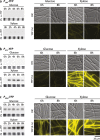Identification and characterization of sugar-regulated promoters in Chaetomium thermophilum
- PMID: 37422618
- PMCID: PMC10329369
- DOI: 10.1186/s12896-023-00791-9
Identification and characterization of sugar-regulated promoters in Chaetomium thermophilum
Abstract
The thermophilic fungus Chaetomium thermophilum has been used extensively for biochemical and high-resolution structural studies of protein complexes. However, subsequent functional analyses of these assemblies have been hindered owing to the lack of genetic tools compatible with this thermophile, which are typically suited to other mesophilic eukaryotic model organisms, in particular the yeast Saccharomyces cerevisiae. Hence, we aimed to find genes from C. thermophilum that are expressed under the control of different sugars and examine their associated 5' untranslated regions as promoters responsible for sugar-regulated gene expression. To identify sugar-regulated promoters in C. thermophilum, we performed comparative xylose- versus glucose-dependent gene expression studies, which uncovered a number of enzymes with induced expression in the presence of xylose but repressed expression in glucose-supplemented media. Subsequently, we cloned the promoters of the two most stringently regulated genes, the xylosidase-like gene (XYL) and xylitol dehydrogenase (XDH), obtained from this genome-wide analysis in front of a thermostable yellow fluorescent protein (YFP) reporter. With this, we demonstrated xylose-dependent YFP expression by both Western blotting and live-cell imaging fluorescence microscopy. Prompted by these results, we expressed the C. thermophilum orthologue of a well-characterized dominant-negative ribosome assembly factor mutant, under the control of the XDH promoter, which allowed us to induce a nuclear export defect on the pre-60S subunit when C. thermophilum cells were grown in xylose- but not glucose-containing medium. Altogether, our study identified xylose-regulatable promoters in C. thermophilum, which might facilitate functional studies of genes of interest in this thermophilic eukaryotic model organism.
Keywords: Eukaryotic thermophiles; Filamentous fungi; Inducible promoters; Thermostable proteins; Transcriptomes.
© 2023. The Author(s).
Conflict of interest statement
The authors declare no competing interests.
Figures





Similar articles
-
Transformation of Chaetomium thermophilum and Affinity Purification of Native Thermostable Protein Complexes.Methods Mol Biol. 2022;2502:35-50. doi: 10.1007/978-1-0716-2337-4_2. Methods Mol Biol. 2022. PMID: 35412229
-
Cloning, expression and characterization of the serine protease gene from Chaetomium thermophilum.J Appl Microbiol. 2009 Feb;106(2):369-80. doi: 10.1111/j.1365-2672.2008.04042.x. J Appl Microbiol. 2009. PMID: 19200305
-
An integrated approach for genome annotation of the eukaryotic thermophile Chaetomium thermophilum.Nucleic Acids Res. 2014 Dec 16;42(22):13525-33. doi: 10.1093/nar/gku1147. Epub 2014 Nov 14. Nucleic Acids Res. 2014. PMID: 25398899 Free PMC article.
-
Interaction network of the ribosome assembly machinery from a eukaryotic thermophile.Protein Sci. 2017 Feb;26(2):327-342. doi: 10.1002/pro.3085. Epub 2017 Jan 14. Protein Sci. 2017. PMID: 27863450 Free PMC article.
-
Developing genetic tools to exploit Chaetomium thermophilum for biochemical analyses of eukaryotic macromolecular assemblies.Sci Rep. 2016 Feb 11;6:20937. doi: 10.1038/srep20937. Sci Rep. 2016. PMID: 26864114 Free PMC article.
Cited by
-
Use of the Saccharomycopsis schoenii MET17 promoter for regulated heterologous gene expression.Curr Genet. 2024 Jul 1;70(1):9. doi: 10.1007/s00294-024-01294-6. Curr Genet. 2024. PMID: 38951203 Free PMC article.
References
-
- Karnaouri A, Antonopoulou I, Zerva A, Dimarogona M, Topakas E, Rova U, Christakopoulos P. Thermophilic enzyme systems for efficient conversion of lignocellulose to valuable products: Structural insights and future perspectives for esterases and oxidative catalysts. Bioresour Technol. 2019;279:362–372. doi: 10.1016/j.biortech.2019.01.062. - DOI - PubMed
Publication types
MeSH terms
Substances
Supplementary concepts
LinkOut - more resources
Full Text Sources
Molecular Biology Databases
Miscellaneous

